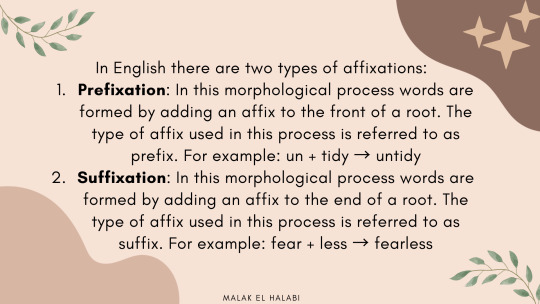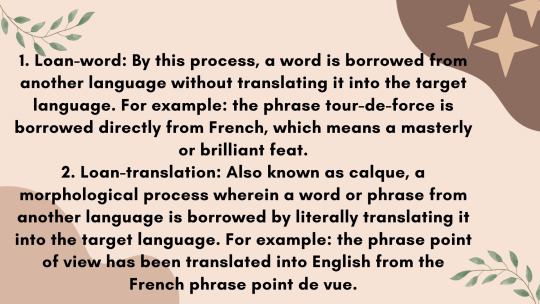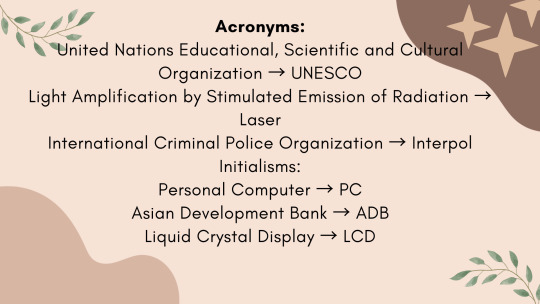Don't wanna be here? Send us removal request.
Text
Hey guy's!!!
You might be wondering about what is Word formation processes and how to use it, So Today, We will discover and discussed about What is Word formation processes and What are it's types.
Word formation processes in morphology
Definition
Word Formation Process (also called Morphological Process) is a means by which new words are produced either by modification of existing words or by complete innovation, which in turn become a part of the language.
Types of Word Formation Processes
Different types of word formation processes are employed to create new words. However, all word formation processes basically bring either inflectional or derivational changes. Therefore, inflection (also called inflexion) and derivation are the two core processes of word formation. Inflection differs from derivation to the following extent:

The major word formation processes include but are not limited to the following:
Affixation
It is a word formation process wherein an affix is attached to a root (also called stem; base) to form a new word. A root is a free morpheme (also called unbound morpheme) that can appear alone. On the other hand, an Affix is a bound morpheme which never occurs by itself, but is always attached to some free morpheme and can be either inflectional or derivational. An Inflectional affix modifies the form/grammatical category of a word, i.e., tense, person, number, gender, case, etc. For example: rat → rats. Contrariwise, a derivational affix modifies the parts of speech of the root, while leaving the grammatical category unchanged. In this way, there is a change of meaning of the root. For example: write → writer.

Conversion
This refers to the change of function or parts of speech of a word without adding an affix. Conversion is also called zero derivation or null derivation since the functional change is brought about by supplementing an invisible affix. Sometimes it is also called functional shift. Typically conversion is made from “noun to verb” and from “verb to noun”. Less frequently, conversion is also done from “adjective to verb” and “adjective to noun”.
For instance:

Back-formation
Back-formation is a morphological process in which new word is created by extracting affixes from another word. In this way, it is the reverse of affixation, in which affixes are added. Back-formation is also different from clipping since it brings a change in the parts of speech or the word's meaning. For example: the noun insertion has been back-formed into verb insert by removing the suffix ion.
Clipping
As the name suggests, clipping is the word formation process in which a word is reduced to a shorter form. With a sharp contrast to back-formation, clipping keeps the original word meaning intact. These words are very common in everyday speech. For instance: lab is the clipped form of laboratory. . There are four types of clippings:

Compounding
Also called composition, by this process two or more than two words are combined together to create a single word, having a single idea and function. In English, there are compound nouns, compound adjectives, and compound verbs. Customarily compound words are spelt as a single word, or as two or more hyphenated words, and even as two or more separate words.
For example:
-life + style → lifestyle
-mother + in + law → mother-in-law
-shopping + mall → shopping mall
There are no specific rules for hyphenated compounds. Generally, some new and original compound nouns are hyphenated, but the hyphen is ignored when they become more familiar. However, there are some compound adjectives that are always hyphenated. For instance: state-of-the-art. The hyphen is often retained when two vowels come together, such as: Co-operation. Hyphens are often used to tell the ages of people and things, for example: 10-year-old. The general rule is that words are combined with hyphens to avoid confusion.
Borrowing
This refers to the words adopted from other languages. There are two types of borrowings:

Coinage
Also called invention, is a morphological process by which new words are invented. Sometimes popular trademark names of various products are adopted by people so extensively that they ultimately become the everyday words of language.
For example:
Heroin
Aspirin
Escalator
Xerox
Kerosene
Nylon
Band-Aid
Vaseline
Margarine
Note: some words are being invented due to rapid cultural changes and the spread of information technology, mass media, internet, etc.
For example:
Google
Blog
Hotspot
Netbook
Tablet
Tweet
Emoticon
Smartphone
Blending
Blending (also called portmanteau) is a morphological process in which the parts of two or more words are combined together to form a new word. Usually, the parts consist of the beginning of one word and the end of the other word(s). Typically, the meaning of the blended word reverberates with the meanings of the original words.
For example:
breakfast + lunch → brunch
motor+hotel → motel
However, blending should not be confused with compounding, which combines two words without truncation of parts of the roots of the blended words.
Acronyms
These words are formed with the initial letters or each of the major parts of a word or a longer phrase. With a few exceptions, acronyms are usually capitalized. Some linguists confuse acronyms with initialisms, which are also abbreviations formed in the similar manner as the former. In essence, there is a sharp difference between the two. In language, an acronym is pronounced as a single word rather than just a sequence of individual letters, which is characteristic of initialisms.
For example:

Reduplication
Reduplication (also called cloning; doubling; duplication; repetition; tautonym) is a word formation process in which a new word is created by repeating all or part of a root or a stem, often with a change of vowel or initial consonant. Reduplication is not a major means of creating lexemes in English, but it is perhaps the most unusual one. Based on their usage, the techniques of reduplication could be classified in the following manner:
Repetition without Change: bye-bye, tick-tick
Rhyming Reduplication: ding-dong, super-duper, bow-wow
Repetition with Change of Vowel: tiptop, chitchat, flip-flop, ping-pong, dilly-dally, wishy-washy
Repetition with Change of Initial Consonant: teeny-weeny.
I hope you learn something new today, thankyou!!
References
“English Word Formation Processes.” Really Learn English. 2016. Really-Learn-English.com.
14 July 2016 <http://www.really-learn-english.com/word-formation-processes.html>.
“Inflection.” Wikipedia. 2016. Wikimedia Foundation Inc. 14 July 2016
<http://en.wikipedia.org/wiki/Inflection>.
“Morphological Derivation.” Wikipedia. 2016. Wikimedia Foundation Inc. 14 July 2016
<http://en.wikipedia.org/wiki/Morphological_derivation>.
Yule, George. The Study of Language. 2nd ed. Cambridge: CUP, 1996.
“Word Formation.” Wikipedia. 2016. Wikimedia Foundation Inc. 14 July 2016
<https://en.wikipedia.org/wiki/Word_formation>.
2 notes
·
View notes